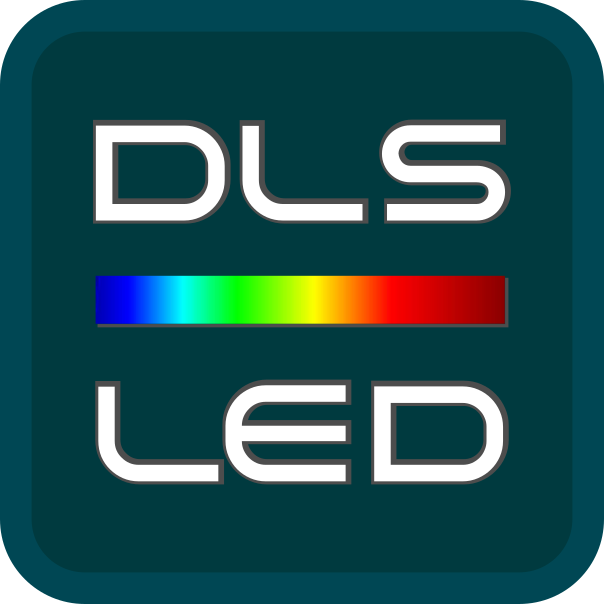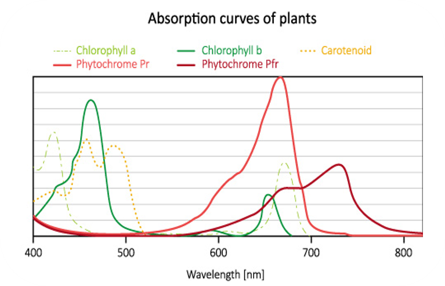DYnamic light spectrum
DLS LED explained
Grass detects when the sun is rising and perceives the color of light received. Extensive research has been conducted on how grass plants 'see' changes in the light spectrum and use these cues to adapt to their dynamic environment. The spectral composition of sunlight is an important signal for grass plants that profoundly influences plant morphology, physiology and development, impacting processes ranging from photosynthesis to defence metabolite production (De Wit et al., 2016).
Using a fixed LED light spectrum does not account for the natural variations in the spectral composition of light that grass plants typically receive. By utilizing a Dynamic Light Spectrum LED strategy, it is possible to simulate daily changing light intensities and spectra that mimic more realistic, natural conditions. This results in healthier plants that are more vigorous and resistant to diseases. Consequently, we recommend using a DLS LED system.
Using a fixed LED light spectrum does not account for the natural variations in the spectral composition of light that grass plants typically receive. By utilizing a Dynamic Light Spectrum LED strategy, it is possible to simulate daily changing light intensities and spectra that mimic more realistic, natural conditions. This results in healthier plants that are more vigorous and resistant to diseases. Consequently, we recommend using a DLS LED system.

Advantages of our Dynamic Light Spectrum
• More efficient distribution of a particular light spectrum.
• Proven strategy in the horticulture market resulting in 10% more harvest in kilograms which correlates to better overall growth results.
• Generating much more light than older HPS SON-T technology which assures optimal plant growth.
• Growth in the most natural way possible.
• The best way to assure that germination, root development and shoot growth are perfectly balanced to create strong and healthy grass.
• This DLS system can be used in a digital dashboard which makes it steerable and adjustable to the needs for specific turf circumstances.
• A less susceptible plant for diseases.
• Proven strategy in the horticulture market resulting in 10% more harvest in kilograms which correlates to better overall growth results.
• Generating much more light than older HPS SON-T technology which assures optimal plant growth.
• Growth in the most natural way possible.
• The best way to assure that germination, root development and shoot growth are perfectly balanced to create strong and healthy grass.
• This DLS system can be used in a digital dashboard which makes it steerable and adjustable to the needs for specific turf circumstances.
• A less susceptible plant for diseases.
We do not believe in the “one spectrum for all” philosophy
Our long-term led supplier and partner MechaTronix has invested heavily in research & development over the last years and is a proud sponsor of the most advanced plant research centers in western europe. Through this approach they have clearly proven what can be achieved with an optimized spectrum per plant and per growth stage.
To understand how your grass will respond to different wavelengths and colors, you need to understand that each grass type and each growth stage requires an individual approach. The amount of light influences the photosynthesis process in the plant. This process is a photochemical reaction in the chloroplasts of the plant cells in which co₂ is converted into carbohydrates under the influence of light energy.
The spectral composition of the different wavelength areas (blue, green, yellow, red, far-red or invisible, e.G. Uv or ir) is important for the growth, shape and development of the plant. For photosynthesis, the blue and red areas are the most important. The timing & duration of light, also called photoperiod, affect the growth and development of grasses in three distinct ways: by providing a cue for the start of the reproductive phase, by modifying the rate of reproductive development once established, and by causing changes in the rate of leaf area expansion and of drymatter production which are not necessarily related to reproduction.
The spectral composition of the different wavelength areas (blue, green, yellow, red, far-red or invisible, e.G. Uv or ir) is important for the growth, shape and development of the plant. For photosynthesis, the blue and red areas are the most important. The timing & duration of light, also called photoperiod, affect the growth and development of grasses in three distinct ways: by providing a cue for the start of the reproductive phase, by modifying the rate of reproductive development once established, and by causing changes in the rate of leaf area expansion and of drymatter production which are not necessarily related to reproduction.

Photosynthetic efficiency is mainly driven by chlorophyll a and b. Chlorophyll a and b are mainly responsible for photosynthesis and the definition of the area for the photosynthetically active radiation par. The photosynthetically active radiation (par) reveals further photosynthetic pigments, also called antenna pigments, such as carotenoids (carotene, zeaxanthin, lycopene, lutein, etc.).
The phytochromes pr (red) and pfr (far red) mainly influence germination, plant growth, leaf structure and flowering. The phytomemic effects are controlled by applying a spectrum with a specific mix of 660 nm and 730 nm to stimulate the pr and pfr phytochromes.
For example during sunrise and sunset, grass receives more far-red light and less red light, triggering a series of morphological and physiological changes aimed at increasing light interception and outcompeting neighboring plants. These changes, collectively known as shade-avoidance syndrome (SAS), include stem elongation, leaf hyponasty, and early flowering (Wollenberg et al., 2008).
By utilizing a Dynamic Light Spectrum LED strategy, it is possible to simulate these daily changing light intensities and spectra that mimic more realistic, natural conditions. This results in healthier plants that are more vigorous and resistant to diseases. Consequently, we recommend using a DLS LED system.
The phytochromes pr (red) and pfr (far red) mainly influence germination, plant growth, leaf structure and flowering. The phytomemic effects are controlled by applying a spectrum with a specific mix of 660 nm and 730 nm to stimulate the pr and pfr phytochromes.
For example during sunrise and sunset, grass receives more far-red light and less red light, triggering a series of morphological and physiological changes aimed at increasing light interception and outcompeting neighboring plants. These changes, collectively known as shade-avoidance syndrome (SAS), include stem elongation, leaf hyponasty, and early flowering (Wollenberg et al., 2008).
By utilizing a Dynamic Light Spectrum LED strategy, it is possible to simulate these daily changing light intensities and spectra that mimic more realistic, natural conditions. This results in healthier plants that are more vigorous and resistant to diseases. Consequently, we recommend using a DLS LED system.
Contact us
Request turf care advice
Request a turf care advice
Are you looking to ensure grass growth and recovery throughout the year, while maintaining a consistently strong and healthy turf pitch?
We can help you reach your goals through our innovative turf care systems and data driven approach. With our innovative approach, we aim to become your reliable and innovation partner in providing a diverse range of turf care and growlight solutions.
We can help you reach your goals through our innovative turf care systems and data driven approach. With our innovative approach, we aim to become your reliable and innovation partner in providing a diverse range of turf care and growlight solutions.
Pages
Contact
Stogger Engineering BV
Maasbreeseweg 55a
5988 PA Helden
the Netherlands
Maasbreeseweg 55a
5988 PA Helden
the Netherlands



